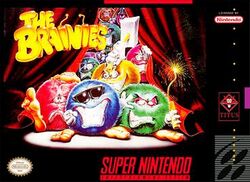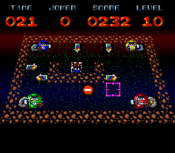Software:The Brainies
| The Brainies | |
|---|---|
 North American cover art for Super NES version | |
| Developer(s) | Atreid Concept Titus France (SNES)[1] |
| Publisher(s) | Loriciels Titus France (SNES)[1] |
| Designer(s) | Didier Capdevielle Pascal Gallon |
| Programmer(s) | François Mathieu |
| Artist(s) | Stéphan Renaudin |
| Composer(s) | Frédéric Motte Philippe Girard |
| Platform(s) | Amiga[2] Amstrad CPC Atari ST MS-DOS Apple IIgs Macintosh Super NES[1] |
| Release | Amiga: Super NES: |
| Genre(s) | Puzzle[1] |
| Mode(s) | Single-player |
The Brainies is a puzzle game released on the Super Nintendo Entertainment System console and Atari ST, Amiga, Apple IIgs, Macintosh, and Amstrad CPC computers. Even though its European title is Tiny Skweeks, the connection to the popular Skweek series was made late.[2] The game is also known as The Tinies on home computers.
Gameplay

The gameplay revolves around Mexican jumping beans (referred to in game as Brainies) as they navigate 101 levels to solve the puzzles that are in their way.[2]
A time limit is in effect; running out of time means losing a life.[2] Players can only control the direction in which a Brainy will walk; taking care not to bump into another Brainy or an obstacle.[2] There are four difficulty levels and the object is to return the Mexican jumping beans safely home. Items can be picked up; they may be beneficial or detrimental to the Brainy depending on certain factors.[2] Arrows can also force a Brainy to change directions, rendering him helpless for a while and possibly messing up a carefully solved puzzle.[2]
Reception
GamePro gave the Super NES version a generally positive review, criticizing that "the icons are too small", but praising the brain-stretching and addictive gameplay.[3]
The Super NES version of the video game was reviewed in one of the first 50 issues of Nintendo Power.[citation needed]
References
- ↑ 1.0 1.1 1.2 1.3 1.4 1.5 "Release information (Super NES)". GameFAQs. http://www.gamefaqs.com/console/snes/data/588227.html. Retrieved 2008-06-04.
- ↑ 2.0 2.1 2.2 2.3 2.4 2.5 2.6 2.7 2.8 "Additional release information/overview". MobyGames. http://www.mobygames.com/game/brainies. Retrieved 2011-11-06.
- ↑ "The Brainies". GamePro (IDG) (67): 68. February 1995.
 |

